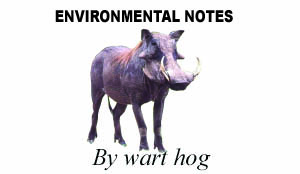 WART Hog would like to thank the Zambia Environmental Management Agency (ZEMA) team for correcting the theme for last week’s commemoration of the international day for the preservation of the ozone layer which appeared in this column on the 13th September 2015. Theme: 30 Years of Healing the Ozone Together – “Ozone: All there is between you and UV.”
WART Hog would like to thank the Zambia Environmental Management Agency (ZEMA) team for correcting the theme for last week’s commemoration of the international day for the preservation of the ozone layer which appeared in this column on the 13th September 2015. Theme: 30 Years of Healing the Ozone Together – “Ozone: All there is between you and UV.”
Wart Hog had some interaction with Taxi and Bus drivers around Lusaka asking the question, what is Carbon Tax? Most drivers indicated a general lack of knowledge about this tax although vehicles in Zambia are required to pay the carbon tax.
Put simply, a carbon tax is a fee levied by governments on the production, distribution or use of fossil fuels such as oil, coal and natural gas. This is a charge based on greenhouse gas (GHG) emissions generated from burning fuels that produce carbon.
It puts a price on each tonne of GHG (mainly carbon dioxide) emitted, sending a price signal that will, over time, elicit a powerful market response across the entire economy, resulting in reduced emissions. It has the advantage of providing an incentive without favouring any one way of reducing emissions over another.
The public’s recognition of global warming has driven lawmakers around the world to negotiate greenhouse-gas reductions. You’ll probably hear a few legislators suggest a “tax” on carbon. But before the word “tax” sets off alarm bells, consider the effect of combusted fossil fuels on the environment.
They cause ozone depletion, acid rain, global climate change and a myriad of other problems. Carbon tax is one of two major market-based options to lower emissions, the other being cap-and-trade schemes. While cap-and-trade seems to have won over most politicians, many economists and consumers prefer carbon tax for its simplicity and impartiality.
By making dirty fuels like oil and coal more expensive, a carbon tax encourages utilities, businesses and individuals to reduce energy consumption and increase energy efficiency. A carbon tax also makes clean, renewable energy from sources such as wind and solar more cost-competitive with fossil fuels.
By reducing fuel consumption, increasing fuel efficiency, using cleaner fuels and adopting new technology, businesses and individuals can reduce the amount they pay in carbon tax, or even offset it altogether.
Despite the long term benefits accruing from the carbon tax, countries such as Australia have repealed legislation that once imposed carbon tax on the country. Such controversies have led to the readjustment to the concept of carbon pricing. Revenue-neutral carbon tax is the newest form of carbon pricing.
Revenue-neutral carbon tax is based on the following principles:
All carbon tax revenue is recycled through tax reductions – The government has a legal requirement to present an annual plan to the legislature demonstrating how all of the carbon tax revenue will be returned to taxpayers through tax reductions. The money will not be used to fund government programs.
The tax rate started low and increases gradually – Starting at a low rate gives individuals and businesses time to make adjustments and respects decisions made prior to the announcement of the tax.
Low-income individuals and families are protected – A refundable Low Income Climate Action Tax Credit is designed to help offset the carbon tax paid by low-income individuals and families.
The tax has the broadest possible base – Virtually all emissions from fuel combustion in captured in Environment National Inventory Report are taxed, with no exemptions except those required for integration with other climate action policies in the future and for efficient administration.
The tax will be integrated with other measures – The carbon tax will not, on its own, meet emission-reduction targets, but it is a key element in the strategy. The carbon tax and complementary measures such as a “cap and trade” system will be integrated as these other measures are designed and implemented.
In simple terms, the amount of tax depends on how much carbon dioxide each type of fuel emits when it is used to run factories or power plants, provide heat and electricity to homes and businesses, drive vehicles and so on.
Essentially, a carbon tax—also known as a carbon dioxide tax or CO2 tax—is a tax on pollution. It is based on the economic principle of negative externalities.
In the language of economics, externalities are costs or benefits created by the production of goods and services. Therefore negative externalities are unpaid costs. When utilities, businesses or homeowners use fossil fuels, they generate pollution that carries with it a cost for society, because the pollution affects everyone.
A carbon tax factors the societal cost of greenhouse gas emissions into the price of the fossil fuels that create them, so the people who cause the pollution have to pay for the necessary impact mitigation.
It is clear to see that carbon taxing is one great initiative of mitigating pollution and regulating factors that contribute to global warming and climate change. However many questions remain about what Zambia is doing to implement carbon pricing.
Wildlife & Environmental Conservation Society of Zambia
P.O. Box 30255, Lusaka, Zambia.
Telefax: 260-211-251630, Cell: 0977-780770
E-mail: wecsz@coppernet.zm






